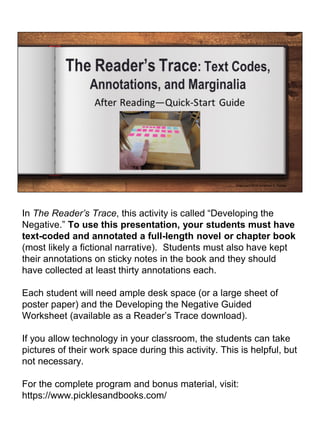
Close Reading with Annotations and Text Codes: After Reading
- 1. In The Reader’s Trace, this activity is called “Developing the Negative.” To use this presentation, your students must have text-coded and annotated a full-length novel or chapter book (most likely a fictional narrative). Students must also have kept their annotations on sticky notes in the book and they should have collected at least thirty annotations each. Each student will need ample desk space (or a large sheet of poster paper) and the Developing the Negative Guided Worksheet (available as a Reader’s Trace download). If you allow technology in your classroom, the students can take pictures of their work space during this activity. This is helpful, but not necessary. For the complete program and bonus material, visit: https://www.picklesandbooks.com/
- 2. The post-reading period is fertile territory for exploration, and I wanted to create an activity to capitalize on this and “close the circle” with reading engagement. In mulling this over, I wondered if one could utilize students’ annotations to literally trace their thoughts throughout their time spent in the text. Specifically, I wondered what the reader’s trace would reveal if presented spatially. Could scrutinizing a student’s annotations as they were laid out on a flat surface yield additional insight into a narrative or, even better, into the student’s reading process?
- 3. Feel free to show additional images and videos on developing film if it will help your students understand the analogy.
- 4. Don’t belabor the film analogy if it is distracting to your students.
- 5. Tell your students not to stress about the image on this slide. This student annotated excessively and possibly to the point of distraction, but it makes for a good preliminary discussion. One need annotate only in a manner that is helpful to the reading process. That will be different for each reader. Ultimately, the reader, with practice and experience, will choose when and how to interact with the text.
- 6. To save time, you could require that this step be completed as homework prior to the activity.
- 7. The image on the next slide shows an example of this.
- 8. Poster boards, tables, and desks will work equally well. Poster boards will allow for portability, however.
- 9. This is metacognition in action!
- 10. There are no correct or incorrect answers. The questions simply prompt readers to reflect on their thoughts as they read.
- 11. Some students will create groupings that are irrelevant or not useful for metacognition. Examples would be grouping annotations based on the color, size, or shape of the sticky notes (unless the student deliberately used colors to designate distinct codes). Encourage the students who do this to regroup.
- 12. The power of this activity comes from prompting students to reflect on their thought processes during and after reading. It is metacognitive. The term metacognition comes from the Greek prefix meta, meaning “beyond,” and cognition, which derives from the word cognoscere, meaning “get to know.” Metacognition is often defined as “thinking about thinking” or “knowing about knowing.” As children grow and develop, they gradually become aware of their own thought processes. They grow beyond thinking to having thought awareness, or metacognition. Thought awareness is similar to self- awareness, by which individuals become aware of their strengths and weaknesses and attempt to establish their identity. Both thought awareness and self-awareness are essential to adolescent development.
- 13. There are no correct or incorrect answers. The questions simply prompt readers to reflect on their thoughts as they read.
- 14. Challenge the students to re-group their annotations. New patterns will emerge and new thinking will result. The students will make surprising connections. Students will struggle here and they will need your support; just avoid giving them the “answers.” There is huge potential for cognitive growth in this activity for those students who create new patterns and reflect upon them. Read the full text of The Reader’s Trace for more information about the psychological processes at work. If the stickies have lost their tackiness, encourage students to use tape to reattach their annotations to their workspace. Be on the lookout for irrelevant patterns. Laying out annotations in the shape of a star just for the sake of making a pretty picture would be off- topic. On the other hand, placing all notes about a particular character in the shape of a “person,” would be relevant to the activity.
- 16. Again, there are no correct or incorrect answers. The questions simply prompt readers to reflect on their thoughts as they read. Celebrate student insight! These “aha” moments are rare but developmentally significant.
- 18. Human beings are social animals. The brain is organized to utilize social interactions to enhance learning. According to educators Renate and Geoffrey Caine, “all students have the capacity to comprehend more effectively when their needs for social interaction are engaged and honored.” Leverage peer interactions whenever possible. This is a perfect opportunity to do so.
- 19. I hope you found these quick-start guides helpful. There is much more available in the full text of The Reader’s Trace, including worksheets, extension activities, and graphic files of each of the many text codes I’ve created to assist you and your students as you annotate.
